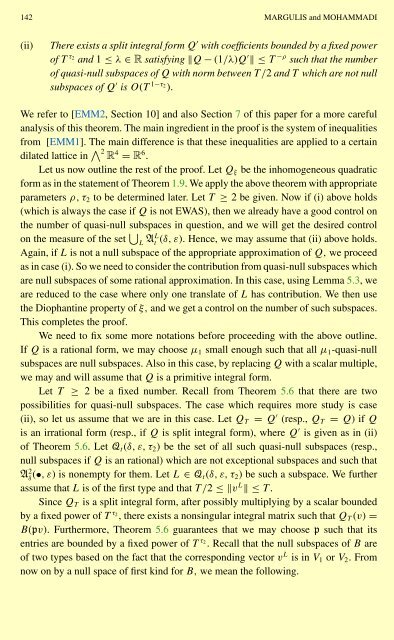NEAR OPTIMAL BOUNDS IN FREIMAN'S THEOREM
NEAR OPTIMAL BOUNDS IN FREIMAN'S THEOREM
NEAR OPTIMAL BOUNDS IN FREIMAN'S THEOREM
You also want an ePaper? Increase the reach of your titles
YUMPU automatically turns print PDFs into web optimized ePapers that Google loves.
142 MARGULIS and MOHAMMADI<br />
(ii) There exists a split integral form Q ′ with coefficients bounded by a fixed power<br />
of T τ2 and 1 ≤ λ ∈ R satisfying Q − (1/λ)Q ′ ≤T −ρ such that the number<br />
of quasi-null subspaces of Q with norm between T/2 and T which are not null<br />
subspaces of Q ′ is O(T 1−τ2 ).<br />
We refer to [EMM2, Section 10] and also Section 7 of this paper for a more careful<br />
analysis of this theorem. The main ingredient in the proof is the system of inequalities<br />
from [EMM1]. The main difference is that these inequalities are applied to a certain<br />
dilated lattice in 2 R 4 = R 6 .<br />
Let us now outline the rest of the proof. Let Qξ be the inhomogeneous quadratic<br />
form as in the statement of Theorem 1.9. We apply the above theorem with appropriate<br />
parameters ρ,τ2 to be determined later. Let T ≥ 2 be given. Now if (i) above holds<br />
(which is always the case if Q is not EWAS), then we already have a good control on<br />
the number of quasi-null subspaces in question, and we will get the desired control<br />
on the measure of the set <br />
L AL t (δ, ε). Hence, we may assume that (ii) above holds.<br />
Again, if L is not a null subspace of the appropriate approximation of Q, we proceed<br />
as in case (i). So we need to consider the contribution from quasi-null subspaces which<br />
are null subspaces of some rational approximation. In this case, using Lemma 5.3,we<br />
are reduced to the case where only one translate of L has contribution. We then use<br />
the Diophantine property of ξ, and we get a control on the number of such subspaces.<br />
This completes the proof.<br />
We need to fix some more notations before proceeding with the above outline.<br />
If Q is a rational form, we may choose µ1 small enough such that all µ1-quasi-null<br />
subspaces are null subspaces. Also in this case, by replacing Q with a scalar multiple,<br />
we may and will assume that Q is a primitive integral form.<br />
Let T ≥ 2 be a fixed number. Recall from Theorem 5.6 that there are two<br />
possibilities for quasi-null subspaces. The case which requires more study is case<br />
(ii), so let us assume that we are in this case. Let QT = Q ′ (resp., QT = Q) ifQ<br />
is an irrational form (resp., if Q is split integral form), where Q ′ is given as in (ii)<br />
of Theorem 5.6. LetQt(δ, ε, τ2) be the set of all such quasi-null subspaces (resp.,<br />
null subspaces if Q is an rational) which are not exceptional subspaces and such that<br />
A2 δ (•,ε) is nonempty for them. Let L ∈ Qt(δ, ε, τ2) be such a subspace. We further<br />
assume that L is of the first type and that T/2 ≤vL≤T. Since QT is a split integral form, after possibly multiplying by a scalar bounded<br />
by a fixed power of T τ2 , there exists a nonsingular integral matrix such that QT (v) =<br />
B(pv). Furthermore, Theorem 5.6 guarantees that we may choose p such that its<br />
entries are bounded by a fixed power of T τ2 . Recall that the null subspaces of B are<br />
of two types based on the fact that the corresponding vector vL is in V1 or V2. From<br />
now on by a null space of first kind for B, we mean the following.

















